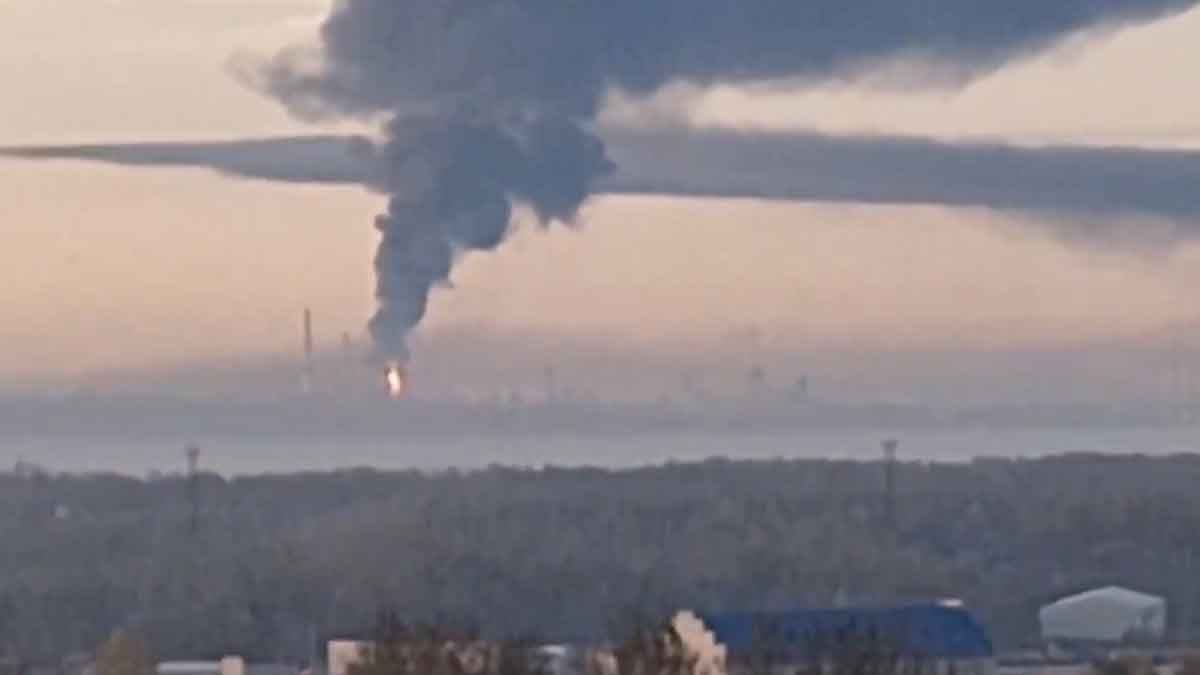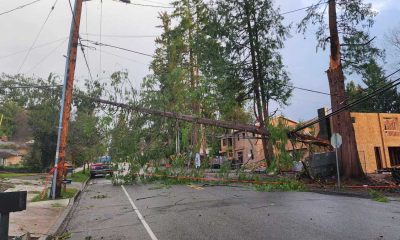International News
Russian Oil Refineries Beyond the Breaking Point as Shortages Spread
A major accident at the Yaroslavl Oil Refinery adds to Russian gasoline, diesel, and aviation fuel woes.

[Kyiv, Ukraine – WBHG News] – On Wednesday, the VT-6 oil process unit at Russia’s fifth-largest oil refinery in Yaroslavl exploded due to an industrial accident. Ukrainian and Russian officials confirmed the incident was not combat-related.
The loss of the VT-6 vacuum distillation tower has taken another 6.2 million metric tons, equivalent to 124,000 barrels per day, of refining capacity offline. The industrial accident happened on the same day that Russian state media agency RBC reported that 38% of Russia’s oil refining capacity is offline due to Ukrainian attacks. According to the report, repairs to damaged refineries are not measured in days or weeks, as the Kremlin claims, but in months and years.
Ukraine started a campaign targeting Russia’s refineries on August 2, carrying out 40 successful attacks on 19 of 38 refineries. A combination of Ukraine’s improved military industrial output, the vast amount of territory Russia needs to defend, 3.5 years of war, and financial constraints has exhausted Russian air defenses.
Last month, Russian officials met with refiners who agreed to delay plant maintenance in an effort to reduce the impact of the Ukrainian attacks. The decision to delay the biannual turnaround season has forced refineries to keep producing summer blend, despite the arrival of colder weather and snow in the far east.
Many Russian refineries in the west were modernized in the previous decade, relying on European and U.S. companies to provide more efficient vacuum distillation units and hydrocrackers. Russia’s vertically integrated oil companies (VOIC), such as Lukoil, adopted the new technology to produce higher-quality gasoline and diesel for sale to European Union distributors.
However, it came at a cost. Due to Russia’s expanded war of aggression against Ukraine and sanctions, refiners don’t have access to critical spare parts that are hard to hide from regulators due to their specialized nature. Ukrainian drones have specifically targeted hydrocrackers and distillation towers since 2024, the very heart of refineries. Even under ideal conditions, it can take 12 to 18 months to replace a destroyed vacuum distillation tower, with Russia lacking the ability to build new ones for modernized plants.
Another problem Russia is facing is that most of the refineries that produce gasoline and aviation fuel are concentrated in the west, well within the range of Ukrainian drones and potential new weapons such as the Flamingo surface-to-surface subsonic cruise missile.
In our assessment, the accident at the Slavneft Yaroslavl Oil Refinery is a byproduct of deferred maintenance, the delay of fall turnaround, and the need to push the remaining undamaged oil refineries beyond their limits. The Russian Ministry of Energy now faces an impossible choice. Every refinery taken offline for scheduled maintenance exacerbates the fuel crisis. Instead of facing planned outages measured in hours or days, repairs after accidents like the one at Yaroslavl will be measured in months.
According to the Ukrainian research group Tochnyi, 60 of Russia’s 83 federal subjects have reported fuel shortages, ranging from sporadic outages at some gas stations to the collapse of fuel distribution. Critical fuel shortages have also been reported in the occupied territories of Ukraine and Georgia.
On Monday, the Russian Ministry of Energy began setting conditions for importing gasoline, diesel, and aviation fuel, waiving import tariffs through June 30, 2026. If Russia starts to import fuel, it will be problematic for the federal budget, which is already under extreme pressure. Moscow will be forced to purchase fuel at a fair market price while attempting to circumvent sanctions and negotiating from a position of weakness.
Additionally, government price controls at the pump are already forcing distributors and service stations to sell gasoline and diesel at a loss. Currently, independent service stations are reporting a 3 to 5 ruble (4 to 6 cents) loss per liter. If Moscow reduces or eliminates price controls, the increases passed on to businesses and consumers will boost inflation, which is already a significant issue. If the price caps are left in place, independent distributors will have an additional incentive to sell to the black market instead of to legitimate buyers. On Wednesday, a coalition of independent service stations warned they are facing bankruptcy if price controls aren’t lifted.
To try and bring the growing crisis under control, Russia extended its existing ban on all gasoline exports through the end of the year. Distributors are now also prohibited from exporting diesel fuel, while VIOCs can continue to sell to foreign customers. The inability to sell refined fuels on the international market is shrinking the income of producers and refiners, and further reducing the federal tax base. Prior to 2022, Russia only had the capacity to export 15% of the gasoline it produced. Export restrictions were enough to solve supply issues in 2023 and 2024, but now there are too many refineries offline.
At least one country, Kazakhstan, has announced that it is seeking new contracts for aviation fuel due to signals that Russia may be forced to restrict kerosene exports. Our analyst team had estimated that Russia would no longer be able to meet its aviation fuel needs if 30% to 35% of refinery capacity was taken offline. The report from RBC, as well as Kazakhstan’s public announcement about diversifying its sources of aviation fuel imports, indicates that the damage to Russia’s refineries is far more severe than previously assessed.
Fuel shortages are not uniform. In Moscow, Lukoil has banned the sale of fuel in gas cans, and some stations have imposed a daily limit on the number of liters a person can purchase. Some independent service stations have been forced to close. On the M-12 Highway Toll Road between Kazan and Moscow, where gas stations are located every 150 kilometers, lines stretch 150 cars deep. In occupied Crimea, over half of the service stations are closed, and fuel purchases are limited to 20 liters, about 5 gallons. In the far east, fuel shortages have been systemic in regions such as Khabarovsk Krai for over a month.
In the occupied territories of Ukraine, Russian milbloggers are reporting that fuel shortages are worse the closer you get to the front lines. In occupied Donetsk, Russian soldiers report that monthly fuel vouchers are exhausted within two weeks, and some distributors are price-gouging the military. Currently, there is no conclusive evidence that fuel shortages are affecting Russia’s combat capabilities.
One beneficiary of the fuel crisis is the Russian black market. Distributors can sell fuel above the government-controlled price cap while avoiding federal taxes. Enough farmers, business owners, and consumers are now willing to pay black market operators between 100 to 200 rubles per liter, equivalent to as much as $9.15 per gallon. Others who cannot or will not pay black market prices have resorted to siphoning fuel from parked cars.
In regions where fuel shortages have become critical, some independent service stations have returned to the post-Soviet era practice of selling fake gasoline. Managers buy low-quality industrial RON AI-70 or AI-76 and then blend it with benzene and other additives. The fuel is then sold as AI-92, equivalent to regular gasoline in the United States, or AI-95, equivalent to mid-grade gasoline. However, the fuel does not match the octane rating and is frequently contaminated with dissolved solids. Drivers in the occupied territories and in southwestern Russia are increasingly reporting engine damage from the adulterated fuel.
At the St. Petersburg Commodities Exchange, distributors are still selling summer blend diesel fuel on the spot market, despite the transition to winter blend normally happening in mid-September. Summer blend diesel starts to form wax crystals around -15°C (5°F), which clogs fuel filters. A few degrees colder, and summer blend diesel fuel can turn into a gel that is too thick for fuel pumps. Sales volumes of diesel continue to decline, partially due to supply restrictions, as well as distributors not wanting to be stuck with October summer blend delivery contracts.
The damage to Russian refineries is causing another problem. Producers are running out of places to store crude oil. In the Urals, roughnecks and other oil field workers are quietly being laid off, and the active well count is starting to decline. If Russia exhausts its terrestrial storage capacity, oil can still be stored in oil tankers outside of ports. However, this costs significantly more than storing oil on land and reduces the number of vessels in Russia’s shadow fleet that can transport crude.
In our assessment, Ukraine no longer needs to strike additional refineries beyond the 19 already targeted. Sustained attacks on already damaged facilities to prevent their repair will be sufficient to intensify Russia’s fuel crisis. We do not see a viable path for Russia to bring lost refinery capacity online in the short or medium term.
Journalism in the United States is under attack. Malcontent News is an independent news agency established in 2016 and a Google News affiliate. To remain independent, we are supported by our subscribers and limit advertising. The easiest way to support our team is to subscribe to our Patreon or Substack.










